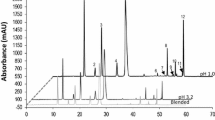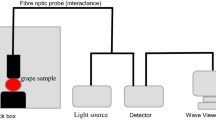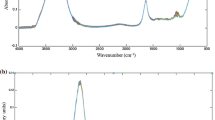Abstract
Attenuated total reflectance mid-infrared (ATR-MIR) spectra were collected from 480 grape skin extracts produced in a wide range of conditions. The conditions were created at different phases in parallel response surface RS-optimisation experiments aiming to maximise the total phenolics in red and white grape skin extractions by microwave-assisted (MAE) or conventional thermal (CTE) methods. Skins mixtures for six white and six red Australian commercial cultivars were prepared from grapes collected at veraison and harvest. The total phenolics were measured for individual extracts with the Folin-Ciocalteu method. Partial least squares (PLS1) regression was employed on the spectra to predict the total phenolics (TP) and colour (CIELAB chroma C*) of individual extracts. Models based on the raw spectra and their second derivative (Savitzky-Golay, 20 points) were examined using the full range of spectra 4000–400 cm−1, and sub-ranges: 4000–1100 cm−1, 1500–400 cm−1, 1500–1100 cm−1 and 1457–1168 cm−1. The PLS1 models based on the second derivative of the range of 4000–1100 cm−1 provided the best results for both TP and C*, for each skin colour. Overall, the residual predictive deviation (RPD) exceeded 3.0, indicating the PLS1 models’ ability for fair classification, suitable for screening. A comparative analysis was performed for the range of 4000–1100 cm−1 between the spectra of white and red skin mixture extracts: the peaks at 3840 cm−1, 2940 cm−1, 2358 cm−1, 2197 cm−1, 2136 cm−1, 1725 cm−1, 1100 cm−1 and 1148 cm−1 are flagged to be investigated in further research. ATR-MIR spectroscopy can reduce the time and costs of TP and C* analyses in grape skin extracts.




Similar content being viewed by others
References
Aleixandre-Tudo JL, Nieuwoudt H, du Toit W (2019) Towards on-line monitoring of phenolic content in red wine grapes: a feasibility study. Food Chem 270:322–331
ASTM Standards on colour and appearance measurement (2000). Sponsored by ASTM Committee E-12 on Colour and Appearance. Sixth Edition. ASTM Stock Number: Colour00, ASTM International, USA
Bechtold T, Mahmud-Ali A, Mussak R (2007) Anthocyanin dyes extracted from grape pomace for the purpose of textile dyeing. J Sci Food Agric 87:2589–2595
Carocho M, Barreiro MF, Morales P, Ferreira ICFR (2014) Adding molecules to food, pros and cons: a review on synthetic and natural food additives. Compr Rev Food Sci Food Saf 13:377–399
Cozzolino D (2011) Infrared methods for high throughput screening of metabolites: food and medical applications. Comb Chem High Throughput Screen 14:125–131
Cozzolino D (2014) Use of infrared spectroscopy for in-field measurement and phenotyping of plant properties: instrumentation, data analysis, and examples. Appl Spectrosc Rev 49:564–584
Cozzolino D, Kwiatkowski MJ, Parker M, Cynkar WU, Dambergs RG, Gishen M, Herderich MJ (2004) Prediction of phenolic compounds in red wine fermentations by visible and near spectroscopy. Anal Chim Acta 513:73–80
Cozzolino D, Kwiatkowski MJ, Waters EJ, Gishen M (2007) A feasibility study on the use of visible and short wavelengths in the near-infrared region for the non-destructive measurement of wine composition. Anal Bioanal Chem 387:2289–2295
Cozzolino D, Cynkar WU, Dambergs RG, Mercurio MD, Smith PA (2008a) Measurement of condensed tannins and dry matter in red grape homogenates using near infrared spectroscopy and partial least squares. J Agric Food Chem 56:7631–7636
Cozzolino D, Kwiatkowski MJ, Dambergs RG, Cynkar WU, Janik LJ, Skouroumounis G, Gishen M (2008b) Analysis of elements in wine using near infrared spectroscopy and partial least squares regression. Talanta 74:711–716
Cozzolino D, Cynkar W, Shah N, Smith P (2011) Feasibility study on the use of attenuated total reflectance mid-infrared for analysis of compositional parameters in wine. Food Res Int 44:181–186
Cozzolino D, Power A, Chapman J (2019) Interpreting and reporting principal component analysis in food science analysis and beyond. Food Anal Methods 12(11):2469–2473
Dambergs RG, Gishen M, Cozzolino D (2015) A review of the state of art, limitations, and perspectives of infrared spectroscopy for the analysis of wine grapes, must, and grapevine tissue. Appl Spectrosc Rev 50:261–278
de la Cerda-Carrasco A, López-Solís R, Nuñez-Kalasic H, Peña-Neira Á, Obreque-Slier E (2015) Phenolic composition and antioxidant capacity of pomaces from four grape varieties (Vitis vinifera L.). J Sci Food Agric 95:1521–1527
Fearn T (2002) Assessing calibrations: SEP, RPD,RER and R2. NIR News 13:12–14
Fragoso S, Aceña L, Guasch J, Busto O, Mestres M (2011) Application of FT-MIR spectroscopy for fast control of red grape phenolic ripening. J Agric Food Chem 59:2175–2183
Galanakis CM (2013) Emerging technologies for the production of nutraceuticals from agricultural by-products: a viewpoint of opportunities and challenges. Food Bioprod Process 91:575–579
Gorinstein S, Weisz M, Zemser M, Tilis K, Stiller A, Flam I, Gat Y (1993) Spectroscopic analysis of polyphenols in white wines. J Ferment Bioeng 75(2):115–120
Gul K, Singh AK, Jabeen R (2016) Nutraceuticals and functional foods: the foods for the future world. Crit Rev Food Sci Nutr 56:2617–2627
Iland P, Dry P, Proffitt T, Tyerman S (2011) The grapevine from science to the practice of growing vines for wine. Patrick Iland Wine Promotions Pty Ltd, Adelaide, South Australia, Australia
Jackman RL, Yada RY, Tung MA, Speers A (1987) Anthocyanins as food colorants- a review. J Food Biochem 11:201–247
Janik LJ, Cozzolino D, Dambergs RG, Cynkar WU, Gishen M (2007) The prediction of total anthocyanin concentration in red-grape homogenates using visible-near-infrared spectroscopy and artificial neural networks. Anal Chim Acta 594:107–118
Jara-Palacios MJ, Rodríguez-Pulido FJ, Hernanz D, Escudero-Gilete ML, Heredia FJ (2016) Determination of phenolic substances of seeds, skins and stems from white grape marc by near-infrared hyperspectral imaging. Aust J Grape Wine Res 22:11–15
Jiménez-Carvelo AM, González-Casado A, Bagur-González MG, Cuadros-Rodríguez L (2019) Alternative data mining/machine learning methods for the analytical evaluation of food quality and authenticity- a review. Food Res Int 122:25–39
Kalli E, Lappa I, Bouchagier P, Tarantilis PA, Skotti E (2018) Novel application and industrial exploitation of winery by-products. Bioresour Bioprocess:5–46
Kuehl RO (2000) Design of experiments. Statistical principles of research design and analysis, Second edn. Brooks/Cole, Cengage Learning
Kwiatkowski M, Kravchuk O, Skouroumounis GK, Taylor DK (2020) Response surface parallel optimization of extraction of total phenolics from separate white and red grape skin mixtures with microwave-assisted and conventional. J Clean Prod 251
Kyraleou M, Pappas C, Voskidi E, Kotseridis Y, Basalekou M, Tarantilis PA, Kallithraka S (2015) Diffuse reflectance Fourier transform infrared spectroscopy for simultaneous quantification of total phenolics and condensed tannins contained in grape seeds. Ind Crop Prod 74:784–791
Lu X, Rasco BA (2012) Determination of antioxidant content and antioxidant activity in foods using infrared spectrosopy and chemometrics: a review. Crit Rev Food Sci Nutr 52:853–875
Machado NFL, Domínguez-Perles R (2017) Addressing facts and gaps in the phenolics chemistry of winery by-products. Molecules 22:286–334
Margalit Y (2004) Concepts in wine chemistry, 2nd edn. The Wine Appreciation Guild, San Francisco
Muhlack RA, Potumarthi R, Jeffery DW (2018) Sustainable wineries through waste valorisation: a review of grape marc utilisation for value-added products. Waste Manag 72:99–118
Musingarabwi DM, Nieuwoudt H, Young PR, Eyéghè-Bickong HA (2016) A rapid qualitative and quantitative evaluation of grape berries at various stages of development using Fourier-transform infrared spectroscopy and multivariate analysis. Food Chem 190:253–262
Naes T, Isaksson T, Fearn T, Davies T (2002) A user-friendly guide to multivariate calibration and classification. NIR Publications, Chichester
Ohno, Y. (2000). CIE fundamentals for colour measurements. IS&T NIP 16 Conference, Vancouver, Canada, 16–20 October
Parker M, Smith PA, Birse M, Francis IL, Kwiatkowski MJ, Lattey KA, Liebich B, Herderich MJ (2007) The effect of pre- and post-ferment additions of grape derived tannin on Shiraz wine sensory properties and phenolic composition. Aust J Grape Wine Res 13(1):30–37
Ristic R, Cozzolino D, Jeffery DW, Gambetta JM, Bastian SEP (2016) Prediction of phenolic composition of Shiraz wines using attenuated total reflectance mid-infrared (ATR-MIR) spectroscopy. Am J Enol Vitic 67(4):460–465
Routray W, Orsat V (2012) Microwave-assisted extraction of flavonoids: a review. Food Bioproc Technol 5:409–424
Shah N, Cynkar W, Smith P, Cozzolino D (2010) Use of attenuated total reflectance midinfrared for rapid and real-time analysis of compositional parameters in commercial white grape juice. J Agric Food Chem 58:3279–3283
Shahidi F (2009) Nutraceuticals and functional foods: whole versus processed foods. Trends Food Sci Technol 20:376–387
Shahid-ul-Islam, Shahid M, Mohammad F (2013) Perspective for natural product-based agents derived from industrial plants in textile applications-a review. J Clean Prod 57:2–18
Singleton VL, Esau P (1969) Phenolic substances in grapes and wine, and their significance. Academic Press, Inc. (Chapters II & III),
Stuart B, George WO, McIntyre PS (1996) In: Ando DJ (ed) Modern infrared spectroscopy. Analytical chemistry by open learning. John Wiley & Sons, Chichester
Teixeira dos Santos CA, Páscoa RNMJ, Lopes JA (2017) A review on the application of vibrational spectroscopy in the wine industry: from soil to bottle. Trends Anal Chem 88:100–118
Vidal S, Francis IL, Noble A, Kwiatkowski MJ, Cheynier V, Waters EJ (2004) Taste and mouth-feel properties of different types of tannin-like polyphenolic compounds and anthocyanins in wine. Anal Chim Acta 513:57–65
Williams PC (2001) Implementation of near-infrared technology. In: Williams PC, Norris KH (eds) Near infrared technology in the agricultural and food industries. American Association of Cereal Chemist, St. Paul, pp 145–169
Acknowledgments
We also thank the School of Agriculture, Food and Wine of the University of Adelaide for supporting this project. We also express our gratitude to C.A. Henschke & Co., Eden Valley in South Australia, particularly Prue Henschke, Stephen Henschke and Craig Markby, for their support of this project.
Funding
This project was funded by the Australia’s grape growers and winemakers through their investment body, the Grape and Wine Research and Development Corporation, which is currently known as Wine Australia.
Author information
Authors and Affiliations
Corresponding author
Ethics declarations
Conflict of Interest
Dr. Daniel Cozzolino declares that he has no conflict of interest. Mariola Kwiatkowski declares that she has no conflict of interest. Dr. Dennis K. Taylor declares that he has no conflict of interest.
Ethical Approval
This article does not contain any studies with human or animal subjects.
Informed Consent
(In case humans are involved) Informed consent was obtained from all individual participants included in the study. (If not applicable on the study) Not applicable.
Additional information
Publisher’s Note
Springer Nature remains neutral with regard to jurisdictional claims in published maps and institutional affiliations.
Rights and permissions
About this article
Cite this article
Kwiatkowski, M., Cozzolino, D. & Taylor, D.K. ATR-MIR Spectroscopy Predicts Total Phenolics and Colour for Extracts Produced by Microwave-Assisted or Conventional Thermal Extraction Methods Applied Separately to Mixtures of Grape Skins from White or Red Commercial Cultivars. Food Anal. Methods 13, 872–884 (2020). https://doi.org/10.1007/s12161-020-01702-w
Received:
Accepted:
Published:
Issue Date:
DOI: https://doi.org/10.1007/s12161-020-01702-w




